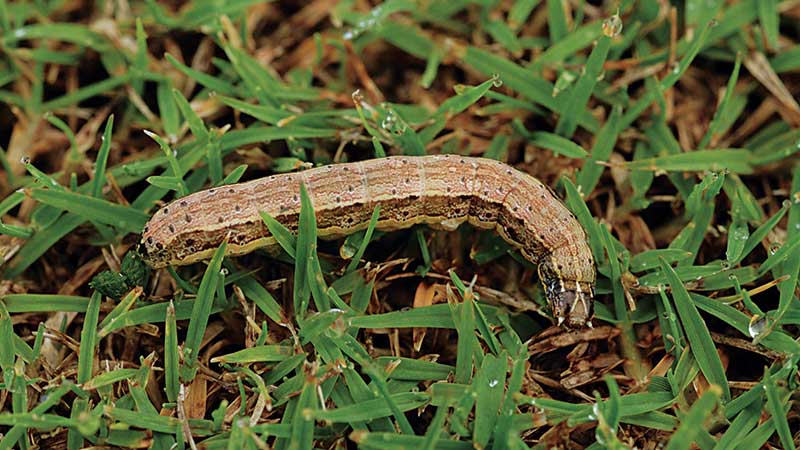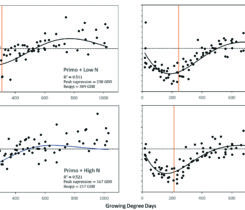How fall armyworms can ravage golf courses without mitigation

Superintendents can identify the turf-loving fall armyworm by the upside-down Y on its head. Most common in the Southeast, the pest can ravage golf courses without mitigation. (Photo by: Lyle Buss, University of Florida)
Fall armyworms, a caterpillar common in the Southeast, can rapidly destroy turf as the larvae hatch and eat leaf tissue. So clearly, the answer is to plant more wildflowers. It’s an unconventional approach, but Adam Dale, Ph.D., a turfgrass and ornamental entomology professor at the University of Florida Institute of Food and Agricultural Sciences, says the flowers attract stinging insects — in a good way.
“The flowering habitat will recruit wasps that will go out and eat these fall armyworms,” Dale says.
Dale says superintendents will likely continue to rely on insecticides, especially during an acute outbreak. Long term, however, using insects to fights caterpillars is about as effective as chemical options, he adds.
Flowering habitats attract predatory insects, primarily the potter wasp. Though it can sting golfers, Dale says the wasps are not territorial and generally avoid people.
However, they absolutely love fall armyworms and will grab armfuls of the larvae, shove them in any hole they can find (spots on the ground, eaves of buildings, knots on trees) and then lay an egg on top of the worms. When the egg hatches, the young wasp has a wormy meal waiting for it.
There are some problems with the approach. Building a habitat is a long-term control solution, and if you have fall armyworms now, you cannot go out and buy a colony of wasps. And, while the wasps attracted by this technique are not aggressive, they can sting golfers if threatened.
“Superintendents are going to use insecticides, so we recommend they use insecticides that are not as toxic to predators,” Dale says, adding that products targeting caterpillars can be effective for short- and midterm fall armyworm outbreaks.
The bacillus thuringiensis bacteria rids courses of caterpillars without harming more helpful insects, Dale explains. Chlorantraniliprole can control fall armyworms for months in a single application, he adds.
Some course superintendents have responded enthusiastically to Dale’s flower-planting suggestions. Wildflowers provide long-term management, beautify courses and offer educational opportunities by posting signs around portions of courses, explaining what flowers are there and why.

Lane Tredway
Syngenta
Lane Tredway, Ph.D.
Technical services manager
You never know when or where a fall armyworm outbreak may occur. Once feeding damage is observed, it becomes an emergency situation. Most insecticides for the fall armyworm control only last for a few weeks, so you can end up chasing them around the golf course for the rest of the summer. Chlorantraniliprole insecticide is a great solution to this problem, providing long-term protection against fall armyworms and other caterpillars. Depending on the application rate, chlorantraniliprole can provide from four weeks to four months of caterpillar prevention. When fall armyworms feed on treated foliage, they are quickly paralyzed by the diamide chemistry to halt feeding activity. Chlorantraniliprole also has a very favorable safety profile — no personal protective equipment is required for applicators, and it has low toxicity to bees and other pollinators.

Rakim K. Turnipseed
FMC Professional Solutions
Rakim K. Turnipseed, Ph.D.
Product development manager, insecticides
Fall armyworms can be quite detrimental to turfgrasses, especially well-fertilized and maintained bermudagrass, fescue, ryegrass, bluegrass and bentgrass. First, look for visual indications such as the presence of birds, wasps and ants. If these natural enemies are present, inspect the turf for frass and larvae or use a soap flush to confirm. Consider mowing the grass if needed, not only to mechanically eradicate some of the larvae, but also to reduce the amount of turf that must be penetrated by chemical insecticides. Insecticides containing bifenthrin, imidacloprid and zeta-cypermethrin are most effective when irrigation is avoided for 24 hours following treatment. However, lightly irrigating the turf just before treatment will aid in translocating fall armyworm larvae to the turf surface, making the pest more vulnerable.
Prime Source

Bret Corbett
Bret Corbett
Director of technical services
Fall armyworms overwinter as pupae in Florida and then emerge as adults and migrate northward. Females lay eggs on the surface of vegetation and structures, including buildings posts and sidewalks. After eggs hatch, the larvae drop to the soil surface to feed on the turfgrass plant. They get their name because they crawl in armies and feed in a linear pattern, consuming everything in sight. Scouting for egg masses on leaf surfaces and soap flushes are effective methods to see if eggs are present. Once the caterpillars get larger, they will burrow into the soil and pupate. Chemical control works best at the early instar larvae stage of the armyworms. Chemical active ingredients that work well against fall armyworms include pyrethroids, acephate, chlorantraniliprole and indoxacarb.

Chuck Silcox, Ph.D.
Amguard Environmental Technologies
Chuck Silcox, Ph.D.
Product development manager
Fall armyworms can occur in large numbers and cause extensive turf damage, typically during August and September. When confronted with large numbers of this pest, a superintendent should immediately apply an insecticide labeled for fall armyworm. A pyrethroid insecticide, such as bifenthrin, or an organophosphate insecticide, such as acephate, are excellent selections. Pyrethroids generally provide longer residual control. Acephate is generally quicker acting and also provides control of late instar mole cricket nymphs, which may be present at this time. Another approach is to control fall armyworms preventively with an application of chlorantraniliprole during the spring or early summer. When applied at a white grub application rate, chlorantraniliprole will provide season-long control of fall armyworms, as well as black cutworm and sod webworms.












